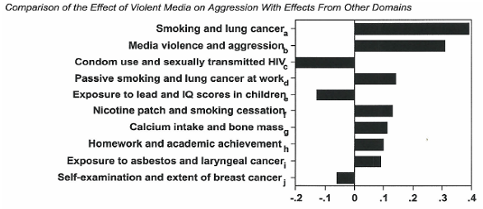- Because Our Children Are Watching
- Join the Cause
- Donate
Written by PTC | Published February 4, 2014
 (1st in a Series about Media Violence)
It’s common sense that what people see on television influences their thoughts, decisions, and behavior. If it didn’t, why would advertisers spend $74 BILLION advertising their goods and services during 2012? Each and every one of those 74,000,000,000 dollars was spent with the intention and expectation of changing the behavior of the viewer. Why would advertisers buy, and television show, commercials at all, if what people watch doesn’t influence their decisions on what to buy? And every parent who has resisted pleas for toys or sugary breakfast cereal KNOWS that TV influences young children!
But does media violence influence and promote violent behavior? Science says “yes.”
Last year, Brad Bushman, professor of psychology at Ohio State University, testified before the House Subcommittee on Commerce, Justice, and Science that “people who consume a lot violent media come to view the world as a hostile place, where violence is ‘normal’ behavior. When people expect others to behave aggressively, they are more likely to behave aggressively themselves. Aggressive youth often consume violent media because it allows them to justify their own behavior as being normal.”
And Bushman isn’t alone. The International Society for Research on Aggression is an organization comprising a world-wide body of scientists dedicated to the study of aggression and violence. In its 2012 report, the ISRA’s Media Violence Commission found that “the effects of violent content are learning effects in the brain…Media characters are attractive role models, especially if their violent actions on the screen are presented as justified and socially acceptable. If the violent content is rewarded and seen as “fun,” then aggression concepts will be classically conditioned with positive feelings. These will likely result in changes to attitudes and beliefs about aggression, such as seeing aggression as a more acceptable response to provocations.”
Dale Kunkel, a professor of communications at the University of Arizona and a member of the American Psychological Association, testified before the before the U.S. Senate Committee on Commerce, Science, and Transportation in 2007 that “there is an elaborate, solid foundation of evidence regarding the cumulative effects of televised violence on children…As exposure accrues over time, year in and year out, a child who is a heavy viewer of media violence is significantly more likely to behave aggressively. Findings from the scientific community make clear that television violence is a troubling problem for our society.”
Douglas Gentile, professor of psychology at Iowa State University, has done numerous studies on the effects of media violence on children. In an article in Pediatrics, Gentile summarized the views of pediatricians – the doctors most familiar with and concerned about child health and development: “Pediatricians almost universally believe that children’s media use negatively affects children in many different areas, including children’s aggressive behavior, eating habits, physical activity levels, risk for obesity, high-risk behaviors, and school performance…Over a thousand studies have established a connection between media violence and aggressive behavior among children. A recent study documented that the negative effects of TV viewing are not restricted to the short term for children and adolescents but increases in violent behavior persist even into adulthood.”
(1st in a Series about Media Violence)
It’s common sense that what people see on television influences their thoughts, decisions, and behavior. If it didn’t, why would advertisers spend $74 BILLION advertising their goods and services during 2012? Each and every one of those 74,000,000,000 dollars was spent with the intention and expectation of changing the behavior of the viewer. Why would advertisers buy, and television show, commercials at all, if what people watch doesn’t influence their decisions on what to buy? And every parent who has resisted pleas for toys or sugary breakfast cereal KNOWS that TV influences young children!
But does media violence influence and promote violent behavior? Science says “yes.”
Last year, Brad Bushman, professor of psychology at Ohio State University, testified before the House Subcommittee on Commerce, Justice, and Science that “people who consume a lot violent media come to view the world as a hostile place, where violence is ‘normal’ behavior. When people expect others to behave aggressively, they are more likely to behave aggressively themselves. Aggressive youth often consume violent media because it allows them to justify their own behavior as being normal.”
And Bushman isn’t alone. The International Society for Research on Aggression is an organization comprising a world-wide body of scientists dedicated to the study of aggression and violence. In its 2012 report, the ISRA’s Media Violence Commission found that “the effects of violent content are learning effects in the brain…Media characters are attractive role models, especially if their violent actions on the screen are presented as justified and socially acceptable. If the violent content is rewarded and seen as “fun,” then aggression concepts will be classically conditioned with positive feelings. These will likely result in changes to attitudes and beliefs about aggression, such as seeing aggression as a more acceptable response to provocations.”
Dale Kunkel, a professor of communications at the University of Arizona and a member of the American Psychological Association, testified before the before the U.S. Senate Committee on Commerce, Science, and Transportation in 2007 that “there is an elaborate, solid foundation of evidence regarding the cumulative effects of televised violence on children…As exposure accrues over time, year in and year out, a child who is a heavy viewer of media violence is significantly more likely to behave aggressively. Findings from the scientific community make clear that television violence is a troubling problem for our society.”
Douglas Gentile, professor of psychology at Iowa State University, has done numerous studies on the effects of media violence on children. In an article in Pediatrics, Gentile summarized the views of pediatricians – the doctors most familiar with and concerned about child health and development: “Pediatricians almost universally believe that children’s media use negatively affects children in many different areas, including children’s aggressive behavior, eating habits, physical activity levels, risk for obesity, high-risk behaviors, and school performance…Over a thousand studies have established a connection between media violence and aggressive behavior among children. A recent study documented that the negative effects of TV viewing are not restricted to the short term for children and adolescents but increases in violent behavior persist even into adulthood.”
 Pediatricians and psychologists agree that “research on violent television and films, video games, and music reveals unequivocal evidence that media violence increases the likelihood of aggressive and violent behavior.” And it should be noted that the primary dissenting view from the research community comes from a psychology professor – an outlier – who personally produces grotesquely and graphically violent media; and yet Hollywood points to him as “proof” that there is some scientific uncertainty on the media violence issue.
In fact, so obvious is the correlation between media violence and real-life violence that in the year 2000, the American Academy of Pediatrics, American Academy of Child & Adolescent Psychiatry, American Psychological Association, American Medical Association, American Academy of Family Physicians, and the American Psychiatric Association issued a joint statement declaring that “reports from the Surgeon General's office, the National Institute of Mental Health, and numerous studies conducted by leading figures within our medical and public health organizations point overwhelmingly to a causal connection between media violence and aggressive behavior in some children.The conclusion of the public health community, based on over 30 years of research, is that viewing entertainment violence can lead to increases in aggressive attitudes, values and behavior, particularly in children.”
Pediatricians and psychologists agree that “research on violent television and films, video games, and music reveals unequivocal evidence that media violence increases the likelihood of aggressive and violent behavior.” And it should be noted that the primary dissenting view from the research community comes from a psychology professor – an outlier – who personally produces grotesquely and graphically violent media; and yet Hollywood points to him as “proof” that there is some scientific uncertainty on the media violence issue.
In fact, so obvious is the correlation between media violence and real-life violence that in the year 2000, the American Academy of Pediatrics, American Academy of Child & Adolescent Psychiatry, American Psychological Association, American Medical Association, American Academy of Family Physicians, and the American Psychiatric Association issued a joint statement declaring that “reports from the Surgeon General's office, the National Institute of Mental Health, and numerous studies conducted by leading figures within our medical and public health organizations point overwhelmingly to a causal connection between media violence and aggressive behavior in some children.The conclusion of the public health community, based on over 30 years of research, is that viewing entertainment violence can lead to increases in aggressive attitudes, values and behavior, particularly in children.”
Enough said! The science is settled. Media violence DOES influence media consumers – especially children.None of this is news. All the way back in 1972, the U.S. Surgeon General warned that “the causal relationship between televised violence and antisocial behavior is sufficient to warrant appropriate and immediate remedial action.” However -- unlike the ban on cigarette advertising on TV, which happened around the same time – no such action protecting children from television violence was forthcoming. And the problem has only gotten worse. Despite horrific events like the shootings in Columbine, Aurora, and Newtown, the entertainment industry continues to pump more and more graphic violence into every living room in America…as we shall see in our next report. SHARE YOUR THOUGHTS BELOW!